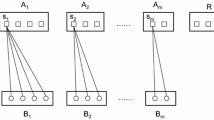Abstract
Facility dispersion seeks to locate the facilities as far away from each other as possible, which has attracted a multitude of research attention recently due to the pressing need on dispersing facilities in various scenarios. In this paper, as a facility dispersion problem, the geometric maximum k-star problem is considered. Given a set P of n points in the Euclidean plane, a k-star is defined as selecting k points from P and linking k − 1 points to the center point. The maximum k-star problem asks to compute a k-star on P with the maximum total length over its k − 1 edges. A linear time approximation scheme is proposed for this problem. It approximates the maximum k-star within a factor of \({(1+\epsilon)}\) in \({O(n+1/\epsilon^4 \log 1/\epsilon)}\) time for any \({\epsilon >0 }\). To the best of the authors’ knowledge, this work presents the first linear time approximation scheme on the facility dispersion problems.
Similar content being viewed by others
References
Agarwal P.K., Varadarajan K.R., Procopiuc C.M.: Approximation algorithms for k-line center. Algorithmica 42(3), 221–230 (2005)
Agarwal P.K., Har-Peled S., Varadarajan K.R.: Approximating extent measures of points. ACM 51(4), 606–635 (2004)
Baur C., Fekete S.P.: Approximation of geometric dispersion problems. Algorithmica 30(3), 451–470 (2001)
Blum M., Floyd R.W., Pratt V.R., Rivest R.L., Tarjan R.E.: Time bounds for selection. J. Comput. Syst. Sci. 7(4), 448–461 (1973)
Cappanera, P.: A survey on obnoxious facility location problems. Technical Report: TR-99-11, University of Pisa (1999)
Chan T.: Faster core-set constructions and data-stream algorithms in fixed dimensions. Comput. Geom. Theory Appl. 35, 20–35 (2006)
Chandra B., Halldorsson M.M.: Approximation algorithms for dispersion problems. J. Algorithms 38(2), 438–465 (2001)
Erkut E.: The discrete p-dispersion problem. Eur. J Oper. Res. 46(1), 48–60 (1990)
Erkut E., Neuman S.: Comparison of four models for dispersing facilities. INFOR: Inf. Syst. Oper. Res. 29(2), 68–85 (1991)
Feige U., Kortsarz G., Peleg D.: The dense k-subgraph problem. Algorithmica 29(3), 410–421 (2001)
Fekete S.P., Merjer H.: Maximum dispersion and geometric maximum weight cliques. Algorithmica 38(3), 501–511 (2004)
Hassin R., Rubinstein S., Tamir A.: Approximation algorithms for maximum dispersion. Oper. Res. Lett. 21, 133–137 (1997)
Klein P.N.: A linear-time approximation scheme for tsp in undirected planar graphs with edge-weights. SIAM J. Comput. 37(6), 1926–1952 (2008)
Kuby M.J.: Programming models for facility dispersion: the p-dispersion and maxisum dispersion problems. Geogr. Anal. 19(4), 315–329 (1987)
Moon I.D., Chaudhry S.S.: An analysis of network location problems with distance constraints. Manag. Sci. 30(3), 290–307 (1984)
Pardalos, P.M., Du, D.Z. (eds.): Network design: connectivity and facilities location. DIMACS Series vol. 40, American Mathematical Society (1998)
Qian J., Wang C.-A.: A linear-time approximation scheme for maximum weight triangulation of convex polygons. Algorithmica 40(3), 161–172 (2004)
Ravi S.S., Rosenkrantz D.J., Tayi G.K.: Heuristic and special case algorithms for dispersion problems. Oper. Res. 42(2), 290–307 (1994)
Ravi, S.S., Rosenkrantz, D.J., Tayi, G.K.: Approximation algorithms for facility dispersion. In: Gonzalez, T.F. (ed.) Handbook of Approximation Algorithms and Metaheuristics 1st edn. Chapman and Hall/CRC (2007)
Resende M.G.C., Pardalos P.M.: The Handbook of Optimization in Telecommunications. Springer, Berlin (2006)
Rosenkrantz D.J., Tayi G.K., Ravi S.S.: Facility dispersion problems under capacity and cost constraints. J. Comb. Optim. 4(1), 7–33 (2000)
Tamir A.: Obnoxious facility location on graphs. SIAM J. Discret. Math. 4(4), 550–567 (1991)
Vazirani V.V.: Approximation Algorithms. Springer, Berlin (2001)
White D.J.: The maximal-dispersion problem. IMA J. Manag. Math. 3(2), 131–140 (1991)
White D.J.: The maximal dispersion problem and the “first point outside the neighbourhood” heuristic. Comput. Oper. Res. 18(1), 43–50 (1991)
Author information
Authors and Affiliations
Corresponding author
Rights and permissions
About this article
Cite this article
Wang, J., Hu, S. A linear time approximation scheme for computing geometric maximum k-star. J Glob Optim 55, 849–855 (2013). https://doi.org/10.1007/s10898-012-9867-6
Received:
Accepted:
Published:
Issue Date:
DOI: https://doi.org/10.1007/s10898-012-9867-6




